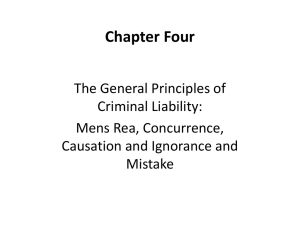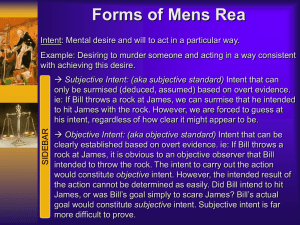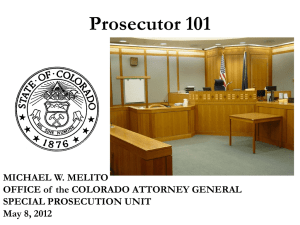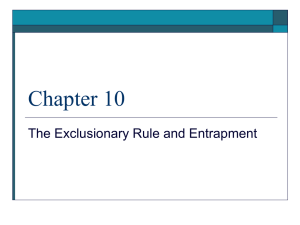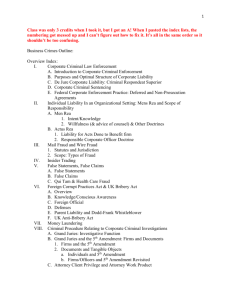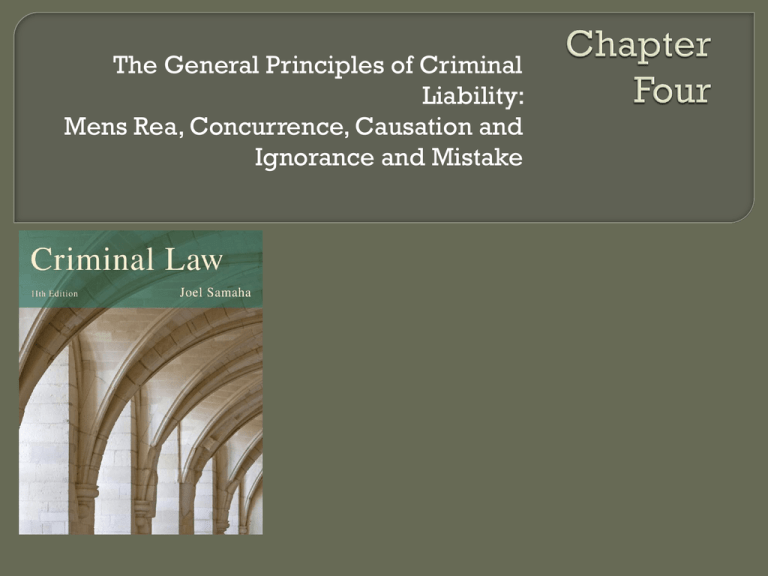
The General Principles of Criminal
Liability:
Mens Rea, Concurrence, Causation and
Ignorance and Mistake
Understand and appreciate that
most serious crimes require
criminal intent and a criminal act.
Understand the difference
between criminal intent and
motive.
Understand the difference
between general and specific
intent.
Understand and appreciate the
differences in culpability among
the Model Penal Codes’ four
mental states—purposefully,
knowingly, recklessly and
negligently.
Understand that criminal liability
is sometimes imposed without
fault (also known as strict
liability.)
To know the definition of
concurrence and why it’s
important in criminal behavior.
Understand that the element of
causation applies only to “bad
result” crimes and be able to
differentiate factual cause from
legal cause.
Understand that ignorance of
facts and law can create a
reasonable doubt that the
prosecution has proved the
element of criminal intent
Voluntary act (prior chapter)
Mens rea—criminal intent
• Most serious crimes require a mental element called mens rea
(criminal intent)
• Required because of culpability or blameworthiness
• Most states and the Federal government follow common law
principles about mens rea
• Mens rea is not one level of intent, it comprises a range of
intent—generally broken down by the degree of
blameworthiness
Concurrence—requirement that criminal intent trigger the
criminal act in conduct crimes; criminal conduct must cause bad
result in bad result crimes
Causation
• Criminal act must be both the cause in fact and the legal cause
of the harm
Ancient
requirement
Complex
• Difficult to prove in court
• Difficult to grasp and define in legislation
Several
mental attitudes that range across
spectrum
Different mental attitudes may apply to
different elements of the crime
Mens rea is different than motive
• Ex. Man kills wife for money
Mens rea= intent to kill
Motive= get money
Motive is something that causes a person to act and is
“irrelevant” to criminal liability
Motive may be important in establishing a defense
Motive may be an element of crime
Motive is also important in some defenses
Confessions
are the only direct evidence
of mental attitude
Proof of intent usually rests on indirect,
circumstantial evidence
It is common in everyday life to infer
people’s intent from what they do
Subjective
mind
fault—fault that requires a bad
• Ex. Receiving an iPod you know is stolen
• Bad state of mind is “knowingly accepting”
• Terms also used to express subjective fault
Ill will, depravity of will, depraved heart
Objective
Fault—fault that requires no bad
mind in the actor
• Ex. Buying an iPod for $10.00 thinking it is new
• Average person would have known that it was
stolen
Criminal
liability that does not require
either subjective or objective fault
• Ex. Statute: whoever receives stolen property
• Notice: there is no requirement that person
knowingly received stolen property
General intent: the intent to commit the criminal act
defined in the statute
• Courts don’t always define general intent the same way
Specific intent: intent to cause the result (in bad
result crimes)
• Generally has subjective fault component
• Deliberate, conscious, intended, planned,
premeditated…etc.
General intent “plus”: intent to commit the criminal
act plus some mental element
• most common definition of specific intent
• Ex. Burglary is specific intent. Burglar has to intend to
break and enter and has to intend to commit some crime
while inside
Facts:
Harris and Tipton got into an argument
while Tipton was driving Harris home. Harris
pushed Tipton out of the vehicle and drove away.
Tipton reported his car as stolen.
Issue: Did Harris intend to carjack his friends
car?
Holding: Court held that the mens rea
requirement for carjacking in Maryland was the
general intent to obtain unauthorized possession
or control of car from person in action possession
by force
Review the link below.
http://dogbitelaw.com/legal-rights-of-dogbite-victims-in-usa/statutory-strict-liabilitystates.html
Does your state have a “Dog Bite Law”?
If so, what are the requirements of the law?
Do you agree with having a “Dog Bite Law”?
Purposefully
Knowingly
Recklessly
Negligently
Product
of debate
Ranked according to degree of
culpability
Actors
conscious object is to engage in
conduct or cause a result
Most blameworthy mental state
To do something on purpose
Having conscious object to commit the
crime, cause the result
(conduct
crime) actor is aware that his
conduct is of a certain nature or that a
circumstance exists
(bad result crime) actor is aware that it is
practically certain that his conduct will
cause such a result
Bad result crimes = practically certain that
conduct will cause the bad result (don’t
need to have a conscious objective)
• Example: surgeon removing cancerous uterus.
Knows/practically certain the surgery will kill the
fetus (but that’s not her intent)
Actor
consciously disregards a substantial
and unjustifiable risk that the material
element exists or will result from his
conduct
Awareness of the risk of causing criminal harm, then
do the act anyway
Recklessness doesn’t apply to conduct crimes
• Have to be aware that you are committing a voluntary act
• Recklessness is the result
Create a risk of harm (don’t intend the harm)
Risk has to be substantial
Risk has to be unjustifiable
Disregarding the risk has to be a gross deviation
from the standard of care a reasonable person would
exercise under the circumstances
Actor should be aware of
a substantial and
unjustifiable risk that the
material element exists
or will result from his
conduct
Risk must be a nature
and degree that actor’s
failure to be aware of the
risk….involves a gross
deviation from the
standard of care
observed by a
reasonable person in the
actor’s circumstance
Unconsciously creating a
risk of harm
Should have been aware
of the risk
Failure to be aware of the
risk is a gross deviation
of the standard of care a
reasonable person would
have under the
circumstances
• A reasonable person would
have realized they were
creating the risk
Risk has to be substantial
Risk has to be
unjustifiable
Facts:
Stark, the defendant, engaged in
unprotected sex knowing he was HIV positive.
Issue: Did Stark intentionally expose his sexual
partners to HIV?
Holding: Sufficient evidence from defendant’s
actions that he purposefully intended to expose
his partners with AIDS
Facts:
Jantzi, the defendant, stabbed Anderson
in the abdomen when Anderson jumped on him
and grabbed his shirt. Jantzi argued he did not
remember making thrusting or swinging motions.
Issue: Did Jantzi knowingly assault Anderson?
Holding : Trial court erred in finding that
defendant acted knowingly. Trial judge
described reckless behavior, so appellate court
reversed and entered judgment on lesser charge.
John, a High school senior, worked from 5:00 am-1:00pm then
took his girlfriend to McDonalds for lunch. On his way home, he
approached a stalled car in the center lane. In order to avoid a
collision, John swerved to the right into the curb lane of traffic.
Although he succeeded in avoiding an accident with the other
car, at least one of the tires on the passenger side of his vehicle
drove off the roadway onto the gravel shoulder. Some of the
gravel on the shoulder was tossed into the air. John applied his
brakes and tried to keep his vehicle on the road. However, he
lost control and the vehicle fishtailed, spun around 180 degrees,
and only stopped after crossing the center line. John’s vehicle
struck a motorcycle throwing the driver in the air, and seriously
injuring him.
Is John’s behavior reckless? Be sure to support your response.
Facts: Koppersmith, the
defendant, and his wife
were arguing on their porch. A physical
confrontation ensued and the defendants wife fell
off the porch and died.
Issue: Did Koppersmith kill his wife recklessly
or negligently?
Holding: Court held that there was evidence
that defendant could have failed to perceive the
risk, so the jury instruction on negligence should
have been given.
Liability
without fault—based on the
voluntary act alone
U.S. Supreme Court has upheld power of
legislatures to make strict liability crimes
• To protect public health and safety
• Make clear they are imposing liability without
fault
Support:
• Strong public interest in protecting public health
and safety. These laws arose out of industrial
revolution and aimed at protecting workers and
citizens from ills of manufacturing, mining,
commerce, etc.
• Penalty is usually (not always, however) mild
Criticism:
• Too easy to expand strict liability beyond
offenses that endanger the public
• It “does no good” to punish people who don’t act
purposefully, knowingly, recklessly, or
negligently
• Criminal law without blameworthiness loses its
appeal as a moral code
Facts: Loge, the
defendant was cited for open
bottle after officers found an empty can of beer in
the vehicle he was driving. Loge argued the
vehicle was his fathers and he did not know it was
in the vehicle.
Issues: Is the “open bottle law” a strict liability
offense?
Holding: Yes. Proof of knowledge was not
required.
Some
mental fault has to trigger the
conduct (conduct crimes)
Some mental fault has to trigger the
conduct and the cause (in bad result
crimes)
Rarely an issue in cases
Holding
an actor accountable for the
results of conduct
Applies only to bad result crimes
Distinguish between two types of
causation—both are necessary in order
to prove criminal liability
• Factual cause (aka “but for” causation, actual
causation, “except for” causation
• Legal cause (aka proximate cause)
Did
the actor set into motion a chain of
events that ended in the result? If so, they
are a factual cause of the result.
But for the actors conduct, the result
would not have occurred.
MPC: Conduct is the cause of a result
when it is an antecedent but for which the
result in question would not have
occurred.
Necessary
to prove that actor was factual
cause of the harm in order to show
criminal liaiblity. BUT, it is not sufficient
to prove criminal liability.
Taken to logical extreme, almost anything
can be the factual cause of something if
you go back far enough….E.g., “had his
mother not given birth, the defendant
would not have been in the place to hit
the victim.”
Necessary to prove that defendant is legal cause of
harm in order to show criminal liability
Legal cause asks whether it is fair to hold defendant
responsible for the harm
Factors in the fairness determination include:
• Whether the result was forseeable from the conduct
• Whether some other factor contributed to the harm
(Intervening harm)
• Whether the intervening factor was a a natural
occurrence? (Natural occurrences don’t generally break
off liability)
When an intervening cause cuts off liability (because
it is more fair to attribute the harm to it) it is said to
be a superseding cause
Facts: Armitage, the
defendant, had been drinking
was driving a boat that capsized. Maskovich, the
defendant’s friend, tried to swim to shore but drown.
Issue: Did Armitage’s conduct cause his friends
death?
Holding: Yes. Court concluded that the victim’s
attempt to swim ashore after defendant’s reckless
boating resulted in a capsized boat was a natural and
continuous sequence arise from defendant’s acts.
Contributory negligence of the victim is not a
defense.
Facts:
Velazquez, the defendant, and Alverez
engaged in a drag race. Both vehicles were
unable to stop at the end of the road. Alverez was
thrown from the vehicle and died.
Issue: Were Velazquez’s actions the legal cause
of Alverez’s death?
Holding: The court held that the defendant was
not the proximate cause of victim’s death. Their
participation in the mutually agreed on activity.
Facts: Kibbe, the
defendant, and Krall, codefendant, gave Stafford a ride with the intent to
rob him. After finding he had no money, they
threw him from the vehicle. While standing in the
middle of the road, Blake, a college student stuck
and killed Stafford.
Issue: Did Kibbe and Krall legally cause
Stafford’s death?
Holding: Court held that Kibbe and Krall were
the proximate cause of victim’s death. The death
could have been foreseen as being reasonably
related to the acts of the defendant and Krall.
Mistake is a defense when it negates the mens
rea
Characterized as either
• A defense of excuse
• A failure of proof defense(can’t prove the requisite
mental state)
MPC- mistake matters when it prevents the
formation of a mental attitude required by a
criminal statute (refer to statute)
Mistake cannot negate criminal liability for strict
liability crimes (because they do not require
mens rea)
Sue is working in a library and brought a laptop
with her. When she leaves, she takes someone
else's laptop, honestly believing it is hers. Is
Sue guilty of a crime? Why or why not?
Ben believes that you don't have to come to a
complete stop at a "Stop" sign when there are no
other cars at the intersection. He rolls through a
stop sign, striking a child on a bike that was
crossing the road. Is Ben guilty of a crime? Why
or why not?
Facts:
Sexton, the defendant, fired a gun killing
Matthews. Sexton did not believe there were
bullets in the gun.
Issue: Did Sexton shoot his friend by mistake?
Holding:
Evidence of an actor’s mistaken
belief relates to whether the State has failed
to prove an essential element of the
charged offense beyond a reasonable
doubt.


